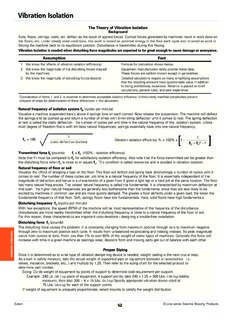Transcription of Noise Control for Building Exterior Heating, Ventilation ...
1 1 Noise Control forBuilding Exterior heating , Ventilation and AirConditioning EquipmentGuidance Sheet9/24/13 Distributed by:New york city Department of Environmental ProtectionThe following is intended to provideguidance and example resources fornoise Control ofbuildingexterior heating , Ventilation and air conditioning(HVAC) equipment. HVAC equipment involves rotating machinery and air moving devices whichgenerate noisethatcan propagate through the open air to nearbynoise sensitive is particularlytrue if the HVAC equipment islocated on the roof of one Building in close proximity orwithadirect line of sight toan adjacent the general approach to Noise Control is the same formany situations, the specificmeasures and solutions need to be carefully selected and implemented.
2 Noise Control measures can be applied at the source, along the pathway, or at thereceptor these reasons, it is highly recommended thatbuildingownersdiscuss their situation with a qualified acousticalconsultant as early as possible. It isalways more cost-effective to design forappropriatenoise controlfrom the beginningrather thantorely on retrofit solutions when Noise becomes a problem later. To aid in theselection of an acoustical consultant, links to several national professional societies areprovided.
3 The NYC DEP canalsoprovide a list of information isnot an exhaustive list of Noise Control products and vendors. It isintended for guidanceand informative purposes only, and should not be construed as anofficial endorsement of any product, vendor, or consultant by the city of New , any Noise Control work or repair done onexterior HVAC systemswill need tocomply with NYC Construction Exterior Noise CriteriaThe NYCN oiseControlCodeSection 24-227specifies the followingHVAC equipment noiselimits: 42 dBALmax (slow)fora single air circulating device 45 dBALmax (slow)for the cumulative Noise level of multiple air circulating devicesBoth limitsapply tonoise levels measuredwithin the receiving propertyat a distance of3feet fromthe open portion of a Noise Control MethodsMany options are available toreduce or avoid excessive Noise from HVAC systems.
4 Sourcecontrols tend to be the most effective because they prevent the Noise from being generatedin the first , unlike interior HVAC Noise that can be due to mechanical Noise ,duct airflow Noise and vibration, Exterior HVAC Noise is essentially comprised solely ofmechanical Noise propagating through the air to nearby receptor followinggoodhousekeeping practices should be considered when installing or retrofittingexteriorHVAC systems: Do not place HVAC equipment near Noise -sensitivereceptors Place HVAC equipment in a separate mechanical room with massive walls/ceiling Select HVAC equipmentwith lower Noise ratings Select fans to operate at peak efficiency Select fan sizes to allow lowest possiblemotor RPM Attachrooftop HVAC equipment tostiff/massive structural elements Avoid duct break-out Noise with lagging cover or chaseway(>2 lbs/SF)
5 Use flexible collars between all major elements Use acoustical louvers for air intake from outdoors Mount HVAC equipment on inertial blocks/rails/curbs Use vibration isolation springs/pads under rotating equipment Use silencers-dissipative/absorptive, reactive/muffler, active electronic Use silencers for air intake and discharge pathways with straight/smooth approach Place silencers as close to Noise source as possible Beware silencer pressure drop(do not exceed inchH2O) and self-generated Noise Enclose rooftop HVAC equipment in a Noise enclosure (provide for adequate airflow) Install a Noise barrier or parapet wall between the HVAC equipment and the receptor(s) A barrier must break theline-of-sight, have no gaps,and be sufficiently massive (>4lbs/SF) Use acoustical absorptive materials on the source side of a barrier or enclosure (NRC > )
6 Example Products and VendorsThe following providescontact informationforfindingHVAC Noise and vibration controlproducts and vendors can provide knowledgeable recommendations forsuitable products for a given situation; however an independent acoustical consultant should beable to provide more comprehensive Noise Control assessments and case-specific Consultants Acoustical Society of Institute of Noise Control National Council of Barriers and EnclosuresProducts designed toattenuate sound levels byblocking the path of soundfrom the source tothe receiver.
7 Acoustax NoiseBarriersNoise Barriers and AcousticalSurfacesAcoustical George KochSonsAcoustical IAC AcousticsType FS, SFS, Acoustic IndustrialNoise ControlOutdoor Noise Barrier, KineticsNoiseBlock louverscan beintegrated into the partition oftheintake/exhaust system of anoutdoor air handling unit, andare lined with acoustical material to absorb sound. ConstructionSpecialtiesModel A12x, A8x, GreenheckModel AFA, AFJ, IAC AcousticsModel Noishield, IndustrialLouvers, 680x, 880x, KineticsModel RuskinModel SilencersDuct silencers are used inside air handlingducts and should be positioned as close to the noisesource as possible.
8 Airflow Noise is absorbed/reduced within the silencers. KineticsRectangular Silencers, Industrial NoiseControlPanl-Flow Vibro-AcousticsDissipative Silencers, McGill AirflowSoundpak AbsorptionAcoustical absorption materials are intended to reduce reverberant (reflected) Noise frominside an enclosure orfrom abarrier surface. It is not intended to act as a barrier by itself. AcousticalSurfacesWall Eckel IndustriesModel EFP, FFP, ALP, IndustrialAcousticsAbsorption Pyrok.
















